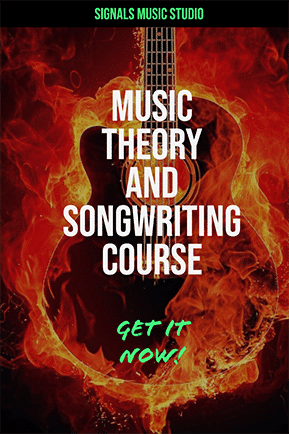Analyzing Queen’s “We Are The Champions”: A Perfect Chord Progression
In 1977, Queen released “We Are the Champions,” and to this day it remains a relevant and iconic anthem. One of the reasons the song is so popular and well-received is because of the absolutely perfect chord progression it’s constructed from. Let’s take a deep look at that progression and figure out how and why it works.
The Opening: Establishing Ambiguous Tonality
The song opens with a simple two-chord pattern in 6/8 time.
This has a strong C minor tonality, and we’d be forgiven for thinking that this section is in Cm. However, the following chords will reveal that it’s more comfortable to parse this from the relative major perspective of Eb. For that reason, I’ll rewrite the chords using the following numerals:
Note – that second chord contains some ambiguity. While it could be called Bb/C (a Bb major triad over a C bass), I hear it more as Gm7/C because it functions like a i-v relationship in C minor.
The Relative Modulation
After cycling between those two chords, we introduce our “real tonic chord” of Eb major. It’s arrival comes with a triumphant boost of optimism, clearing away some of the darkness we just experienced. It is paired up with the IV chord of the key, Ab, to form this simple progression:
Notice how the IV chord is placed in second inversion, keeping the bass note consistent across both of these chords. We’ve seen this in nearly every other perfect progression analyzed on this site, proving it’s a popular and valuable chord change.
Building Energy: The Pre-Chorus
The progression becomes more energetic as we approach the chorus:
This is a fun progression that starts with an exceedingly popular movement (I-V63-vi) and gets interesting with that F7. That’s a secondary dominant – the V7/V – that helps us resolve to Bb. The presence of that F7 creates a ii-V-I in the key of Bb major (Cm-F7-Bb).
Those first three chords though, as mentioned, show up over and over in different keys. Here’s a few examples that are highlighted in the Chord Progression Codex, which teaches chord theory from the ground up while analyzing popular songs like this.

The Surprise Modulation
Here’s where Queen does something completely unexpected. After hanging on that Bb chord (the V in Eb), you’d expect to resolve back to Eb. V leads to I, right?
Not this time. Instead, they jump up a whole-step from Bb, landing on C. This C is treated like a V7 chord, and resolves us to a brand new key of F major through a V-I resolution (C to F). It’s comical and unexpected, but it works brilliantly.
The Chorus: Emotional Complexity
The chorus progression is quite simple. Just remember, we’re now in the key of F major!
This might look like basic stuff, but I think there’s emotional complexity hidden within these simple. The F to A minor change (I to iii) is one of the saddest chord changes you’ll find in a major key. Following that with D minor adds even more melancholy.
Why all this sadness in a victory song? The lyrics explain it – this isn’t about easy triumph. It’s about paying dues, enduring hardship, and fighting through adversity. A real champion’s anthem reflects both the glory and the struggle.
That chord progression begins to repeat, but closes off with more interest. Instead of a measure split between Bb and C, we’re given a disruptive F#º7:
Where does that F# diminished seventh chord come from? It’s hard to tell without looking ahead at the next chord, which will be Gm7, the ii chord.
Knowing that, we can see that F#º7 is just acting like a secondary leading tone chord. It pulls our ear up a half-step to resolve sweetly on the ii, so we’ll call it the viiº/ii (or “seven of two”).
That Bbm6 is a heartbreaker of a chord. We can see that it’s a minor version of the IV chord – normally we’d play Bb major as the IV in this key, but here we’re playing Bbm instead. This is an extremely common borrowed chord to see, and this one specifically always has the same effect- instant emotion and bittersweet sorrow.
It’s been enhanced with a natural 6th to give it a chord label of Bbm6 and is pronounced Bb Minor Six. Don’t confuse that m6 as meaning a minor sixth interval – there is no b6 in a m6 chord!
That borrowed iv chord transforms itself into an Edim, as its fifth (F) gets lowered a half-step to E. It’d be best to label that chord Edim7, which is the viiº in our key of F. As expected, viiº or Edim will pull us up to F major, the tonic, for the next section.
“Nah-nah-boo-boo”
The concluding melodies of the chorus (“No time for losers…”) contains a melody that is quite reminiscient of a school yard taunt heard across the world. I don’t think it’s a coincidence that the braggadocious lyrics are sung in such a mocking contour, but I can’t say for sure that this was intentional!
That “nah-nah-boo-boo” melody happens atop the following chords, which feature a rising bass voice from the tonic to the fifth
That ascending bass line is the opposite of a lament bass. Instead of walking down in defeat, we climb up victoriously: F-G-Ab-Bb-C. This creates a triumphant feeling as the harmony moves through increasingly complex modal mixture.
I think it’s helpful to call Eb, Ab, and Bb all borrowed chords from parallel Dorian, since they all fit neatly into that parallel mode. The last chord, C7sus4, is a hollow, unresolved dominant that builds maximum tension. The Eb chord in particular has more going on that what I’m writing here – I believe it also includes a 9th and a #11.
It All Repeats
We’ve built up an expectation here with this C7sus4 chord to finally resolve back to F major. We get Fm instead, and play with F dorian for a bit before finally repeating things.
Learn More
If you’d like to learn more about music theory and how it can help us write amazing music like Queen’s, you should consider buying my Music Theory and Songwriting Course. It’s a thorough and comprehensive curriculum that will teach you all of the important elements to songwriting, including music theory.







